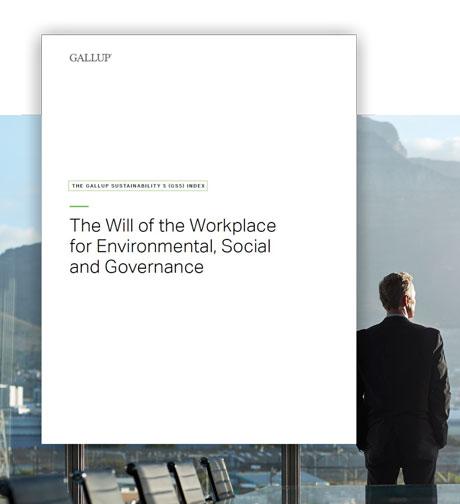Story Highlights
- Demand for ESG activity climbs among investors
- Half-hearted ESG efforts create genuine financial risk
- Committing to ESG attracts investors, loyal customers and top-tier talent
ESG is here. Are you aware of the commitment required to execute your ESG strategy?
The demand for environmental, social and governance (ESG) progress is pushing the international business community to reconsider their purpose beyond maximizing profit for shareholders. Depending on your industry and organizational culture and history, this is something your people are anticipating with excitement or anxiety. Likely both.
Of course, this movement is not entirely new. Corporate social responsibility (CSR) emerged in the 1990s as a conceptual framework to help organizations think about how they affect society around them. What's different now is that stakeholders have the information, voice and audience to demand real, verifiable, substantial change on these issues.
The reasons ESG progress is a popular topic at this moment in history are complex: It's a generational shift. It's technological change. It's a consequence of our information age. It's everything from the Paris Agreement to the death of George Floyd. Corporations are awakening to their role in society and their influence on the planet -- and their need to be responsive to it all.
Corporate leaders are educating themselves and preparing for new ESG reporting standards. But it would be a mistake to assume that all leaders are equally committed to the goals and outcomes that these standards are intended to support.
As Gallup has advised our clients and reviewed what corporations worldwide are doing about ESG strategy, it's clear that organizations are taking one of two paths.
Path One: The Reactive and Noncommittal
Some leaders know that the winds of the marketplace are changing -- customers and citizens demanding transparency and change, investors and regulators requiring disclosures -- and they are smart enough to change with them.
Fundamentally, they don't want their company to look bad. If investors want plans to increase leadership diversity, organizations can present a rosy outlook. If customers want to know about carbon footprints, it's ultimately a job for the marketing department. When an ethics crisis erupts, it's a PR problem.
We call this the path of minimal compliance. Companies simply factor new regulations and rules into the cost of doing business. If it doesn't have to be public, it won't be shared. If it's not legally required, it's not expected of employees. If nobody notices a problem, it doesn't exist.
If it doesn't have to be public, it won't be shared. If it's not legally required, it's not expected of employees. If nobody notices a problem, it doesn't exist.
It's a reactive approach. A leader may be able to point to "everything" they've done for the environment, social issues or ethics. But external factors dragged them the whole way. It's business as usual, even if it has the appearance of change.
But it's ultimately an illusion. Like the old Looney Tunes cartoon -- Wile E. Coyote sees a tunnel through a mountain, runs full speed ahead and smacks face first into a painting; the road ahead was an illusion.
In the same way, leaders who choose feel-good metrics and feel-good reports may think their company is on the road to ESG. But they will find out, eventually, that they've introduced enormous risks to their organization. By keeping up appearances, they've only fallen further behind.
ESG measures are becoming part of capital-raising compliance. It is becoming harder to access credit or raise capital.
At a minimum, risk premiums will rise, increasing the cost of capital and making it more difficult to compete and win in the market. And that's the easy stuff. Consumer backlash to greenwashing and performative gestures on social issues are much more challenging. And when it comes to ethics, the risks are existential.
ESG measures are becoming part of capital-raising compliance. It is becoming harder to access credit or raise capital.
Path Two: The Proactive and Committed
Other leaders are far ahead of the pack already when it comes to their organization's ESG strategy.
Some organizations have had ESG strategy built into their mission, purpose and cultural DNA from day one. Along the way, they've disproven the myth that organizations must choose between doing well financially and doing good by stakeholders and for the planet.
Likewise, some established organizations have committed the resources and long-term effort to transform themselves. They are already accruing the rewards -- for example, attracting ESG-savvy investors, loyal customers and top-tier talent.
But the reality is two-fold: They did not take the easy path, and they did not wait for others to change first.
When you dig into the public reports ESG-committed organizations publish, the difference becomes obvious. Feel-good reports combine ambitious -- but unrealistic -- goals with no metric or measure to substantiate progress or achievement.
In contrast, committed ESG leaders are putting out reports with challenging but realistic targets, disclosing metrics that aren't always positive news, and revealing plausible action plans for narrowing the gap. You can tell that these leaders are interested in metrics that predict real performance and true change.
Moreover, leaders who are truly committed to ESG don't expect to have all the answers upfront. They have an experimental mindset. Let's try this. Does this improve outcomes? No? OK, let's try something else. The learning process becomes the engine of long-term performance and growth. Tough metrics get you there; fluff metrics do not.
However, this path is not without risks. Setting a high bar can make organizations appear to be failing, compared with competitors who use low-bar measurements and reporting. Of course, professional investors can spot the difference. But customers (and the general public) may not.
In addition, organizations that attempt to transcend current best practices are likely to make mistakes. When we've talked to the CHROs of some of the world's leading corporations about their DEI initiatives, they've been candid with us: We've made mistakes. We've had to backtrack and change course. But it's a long-term commitment. And you've got to be prepared for trial-and-error.
The long-term rewards, however, are substantial and lasting. Leading ESG organizations will attract the best people, generate loyal brand advocates and have easier access to capital. In addition, leaders will leave a legacy that makes them proud.
People, Planet and the Will of the Workplace
Courage has always been rare. And this year will be a defining moment in many board rooms. Many executive teams are going to choose the path of minimum compliance. Fewer companies will choose the path of long-term, leader-driven commitment to change.
Leading ESG organizations will attract the best people, generate loyal brand advocates and have easier access to capital.
For those who take the proactive path, picking the right metrics will matter a lot. They will ultimately tell you if what you're doing is effective. The right metrics are especially important when it comes to measuring the attitudes of your people.
The voice of your employees is essential to ESG success. After all, it's your people who will have to push themselves to be more creative, innovative and focused. A workforce committed to ESG is the fuel that drives ESG performance. And a committed workforce allows the organization to do well by doing good.
Business leaders are at a crossroads: How are you going to measure progress on ESG? And how are you going to measure your employee attitudes on ESG? Will you pick the easy, PR-friendly route? Or will you commit to measurements that truly predict success?
Measure progress on your ESG initiatives using the voice of employees.
- Ask your employees to rate these five survey items. They're highly predictive of future outcomes and openly available for you to use.
- Download our perspective on ESG to learn why including the voice of the employee is so important.



